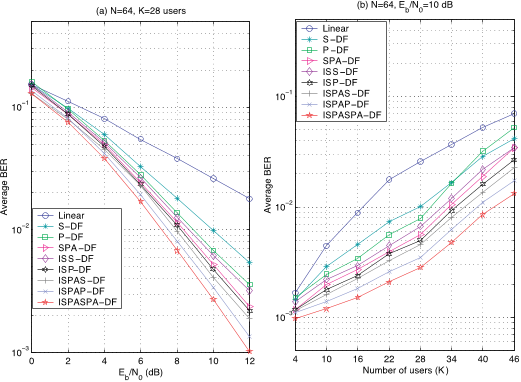




read more











The motivation for the proposed encoded structure is that significant gains can be obtained from iterative techniques with soft cancellation methods and error control coding [17]-[23] and from efficient receivers structures and ordering algorithms such as the novel SPA-DF detector.
The role of reversing the cancellation order in successive stages is to equalize the performance of the users over the population or at least reduce the performance disparities.
In particular, the feedback filter fk(i) of user k has a number of non-zero coefficients corresponding to the available number of feedback connections for each type of cancellation structure.
The ISPAP-DF scheme can save up to 1.4 dB and support up to 8 more users in comparison with the ISP-DF for the same BER performance.
the ISPASPA-DF detector can save up to 1.8 dB and support up to 10 additional users in comparison with the ISP-DF for the same BER performance.
2. The proposed iterative (turbo) receiver structure consists of the following stages: a soft-input-soft-output (SISO) SPA-DF detector and a maximum a posteriori (MAP) decoder.
It is worth noting that the linear and P-DF detectors experience performance losses for coded systems, relative to the other structures, as verified in [14] and which is a result of the loss in spreading gain that increases the interference power at the output of the MMSE receiver.
An iterative receiver with hard-decision feedback is defined by:z(m+1)(i) = WH(i)r(i) − FH(i)b̂(m)(i) (23)where the filters W and F can be S-DF or P-DF structures, and b̂m(i) is the vector of tentative decisions from the preceding iteration that is described by:b̂(1)(i) = sgn ( ℜ [ WH(i)r(i) ])(24)b̂(m)(i) = sgn ( ℜ [ z(m)(i) ]) , m > 1 (25)where the number of stages m depends on the application.
The MAP decoder also computes the a posteriori LLR of every information bit, which is used to make a decision on the decoded bit at the last iteration.
Iterative Turbo Receiver and DecodingA CDMA system with convolutional codes being used at the transmitter and the proposed iterative SPA-DF receiver with turbo decoding is illustrated in Fig.
For this reason, the authors adopt L = 4 for the remaining experiments because it presents a very attractive trade-off between performance and complexity.
From the curves, the authors observe that a disadvantage of S-DF relative to PDF is that it does not provide uniform performance over the user population.
The decoding of the proposed iterative detection schemes that employ the SPA-DF detector (ISPAS-DF, ISPAP-DF and ISPASPA-DF) resembles the uncoded case, where the second stage benefits from the enhanced estimates provided by the first stage that now employs convolutional codes followed by a Viterbi decoder with branch metrics based on the Hamming distance.
These estimates are used to compute the detector a posteriori probabilities P [bk(i) = ±1|z(m)k (i)] which are deinterleaved and input to the MAP decoder for the convolutionalcode.
As occurs with S-DF receivers, a disadvantage of the SPA-DF detector is that it generally does not provide uniform performance over the user population.
This is an important feature of the proposed detectors as they can save considerable computational resources by operating with a lower number of turbo iterations.